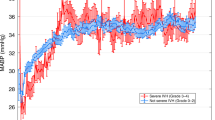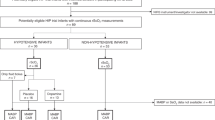Abstract
OBJECTIVE: To determine mean arterial pressure values during the first 24 hours for “stable” and “unstable” extremely low birth weight (ELBW) infants and to ascertain its association with perinatal factors.
BACKGROUND: In ELBW infants, hypotension is diagnosed by nonspecific clinical signs together with reference arterial pressure values extrapolated from regression models or from scarce actual observations.
DESIGN: Retrospective cohort study.
METHODS: 101 ELBW (≤600 g) infants born in our medical center (1989–2000). Considered stable were 36 infants with umbilical cord hemoglobin ≥14 g/dl who, although mechanically ventilated, had normal acid–base balance, no patent ductus arteriosus, had not received indomethacin, steroids, muscle relaxants, narcotics, were never treated for hypotension and survived at least 7 days. The remaining 65 infants constituted the unstable group. Arterial pressures were determined by oscillometry (OBP) and direct transducer readings through an umbilical line (MAP). All admission and 10% of the readings were by OBP; the remaining 1877 measurements were by MAP.
RESULTS: Stable and unstable infants were similar in birth weight, demographics, history of chorioamnionitis, antepartum steroids, low Apgar scores, administration of epinephrine during resuscitation, and sepsis. Stable infants were different from unstable in gestational age (27±2 vs 25±2 weeks' gestational age [w GA]), history of preterm labor, preeclampsia, and neonatal mortality (22 vs 68%). Admission OBP (30±7 vs 29±10 Torr) were similar and 1-hour MAP were different (30±6 vs 27±7 Torr) between both groups. MAP for stable infants was higher throughout the 24 hours. Greater differences were noted between 3 and 6 hours when 34 of 65 unstable infants were treated for hypotension. Mean MAP and 10 percentile values for stable infants at 1, 3, 6, 12, and 24 hours were 30 (22), 31 (24), 32 (25), 34 (24), and 35 (28) Torr, respectively. MAPs did not correlate with birth weight, but they were lower among 19 stable infants ≤26 w GA than among 17 stable infants ≥27 w GA. History of preeclampsia, antenatal steroids, intratracheal epinephrine and cord hemoglobin did not influence MAP. Low 1-minute Apgar score and intracranial hemorrhage were associated with low MAP during the first day.
CONCLUSION: There is a wide variation of GA among ELBW infants. MAPs increase with GA and with postnatal age. Shortly after birth, arterial pressures are similar for stable and unstable infants. Failure to increase MAP between 3 and 6 hours of life should create concern. MAP ≤28 Torr at 3 hours of life is a reasonable, but not absolute, predictor of the need for hypotension treatment.
This is a preview of subscription content, access via your institution
Access options
Subscribe to this journal
Receive 12 print issues and online access
$259.00 per year
only $21.58 per issue
Buy this article
- Purchase on Springer Link
- Instant access to full article PDF
Prices may be subject to local taxes which are calculated during checkout


Similar content being viewed by others
References
Tyson JE, Younes J, Verter J, Wright LL . Viability, morbidity, and resource use among newborns of 501–800-g birth weight JAMA 1996; 276: 1645–51
Lorenz JM . Survival of the extremely preterm infant in North American in the 1990s Clin Perinatol 2000; 27: 255–62
Miall-Allen VM, de Vries LS, Dubowitz LMS, Whitelaw AGL . Blood pressure fluctuation and intraventricular hemorrhage in the preterm infant of less than 31 weeks' gestation Pediatrics 1989; 83: 657–61
Watkins AMC, West CR, Cooke RWI . Blood pressure and cerebral haemorrhage and ischaemia in very low birthweight infants Early Hum Dev 1989; 19: 103–10
Bada HS, Korones SB, Perry EH et al. Mean arterial blood pressure changes in premature infants and those at risk for intraventricular hemorrhage J Pediatr 1990; 117: 607–14
Cunningham S, Symon AG, Elton RA, Zhu C, McIntosh N . Intra-arterial blood pressure reference ranges, death and morbidity in very low birthweight infants during the first seven days of life Early Hum Dev 1999; 56: 151–65
Seri I, Evans J . Controversies in the diagnosis and management of hypotension in the newborn infant Curr Opin Pediatr 2001; 13: 116–23
Al-Aweel I, Pursley DM, Rubin LP, Shah B, Weisberger S, Richardson DK . Variations in prevalence of hypotension, hypertension, and vasopressor use in NICUs J Perinatol 2001; 21: 272–8
Kitterman JA, Phibbs RH, Tooley WH . Aortic blood pressure in normal newborn infants during the first 12 hours of life Pediatrics 1969; 44: 959–68
Versmold HT, Kitterman JA, Phibbs RH, Gregory GA, Tooley WH . Aortic blood pressure during the first 12 hours of life in infants with birth weight 610 to 4,220 grams Pediatrics 1981; 67: 607–13
Shortland DB, Evans DH, Levene MI . Blood pressure measurements in very low birth weight infants over the first week of life J Perinat Med 1988; 16: 93–7
Spinazzola RM, Harper RG, de Soler M, Lesser M . Blood pressure values in 500- to 750-gram birthweight infants in the first week of life J Perinatol 1991; XI: 147–51
Hegyi T, Carbone MT, Anwar J et al. Blood pressure ranges in premature infants: I. The first hours of life J Pediatr 1994; 124: 627–33
Nuntnarumit P, Yang W, Bada-Ellzey HS . Blood pressure measurements in the newborn Clin Perinatol 1999; 26: 981–96
Lee J, Rajadurai VS, Tan KW . Blood pressure standards for very low birthweight infants during the first day of life Arch Dis Child 1999; 81: F168–70
Kluckow M, Evans N . Relationship between blood pressure and cardiac output in preterm infants requiring mechanical ventilation J Pediatr 1996; 129: 506–12
Piazza SF, Chandra M, Harper RG, Sia CG, McVicar M, Huang H . Upper- vs. lower-limb systolic blood pressure in full-term normal newborns Am J Dis Child 1985; 139: 797–9
Park MK, Menard SM . Accuracy of blood pressure measurement by the Dinamap monitor in infants and children Pediatrics 1987; 79: 907–14
Diprose GK, Evans DH, Archer LNJ, Levene MI . Dinamap fails to detect hypotension in very low birthweight infants Arch Dis Child 1986; 61: 771–3
Zubrow AB, Hulman S, Kushner H, Falkner B . Determinants of blood pressure in infants admitted to neonatal intensive care units: a prospective multicenter study J Perinatol 1995; 15: 470–9
Moscoso P, Goldberg RN, Jamieson J, Bancalari E . Spontaneous elevation in arterial blood pressure during the first hours of life in the very-low-birth-weight infant J Pediatr 1983; 103: 114–7
Report of a Joint Working Group of the British Association of Perinatal Medicine and the Research Unit of the Royal College of Physicians. Development of audit measurements and guidelines for good practice in the management of neonatal respiratory distress syndrome Arch Dis Child 1992; 67: 1221–7
Cabal LA, Reed J, Miller F . Elevated blood pressure in infants of preeclamptic mothers [Abstract] Pediatr Res 1981; 15: 459A
Moïse AA, Wearden ME, Kozinetz CA, Gest AL, Welty SE, Hansen TN . Antenatal steroids are associated with less need for blood pressure support in extremely premature infants Pediatrics 1995; 95: 845–50
Author information
Authors and Affiliations
Rights and permissions
About this article
Cite this article
Cordero, L., Timan, C., Waters, H. et al. Mean Arterial Pressures During the First 24 Hours of Life in ≤600-Gram Birth Weight Infants. J Perinatol 22, 348–353 (2002). https://doi.org/10.1038/sj.jp.7210736
Published:
Issue Date:
DOI: https://doi.org/10.1038/sj.jp.7210736



